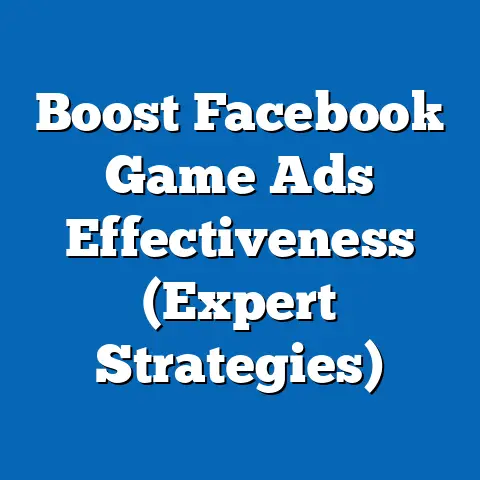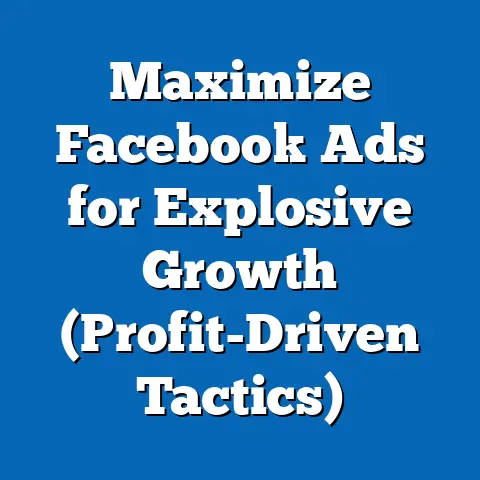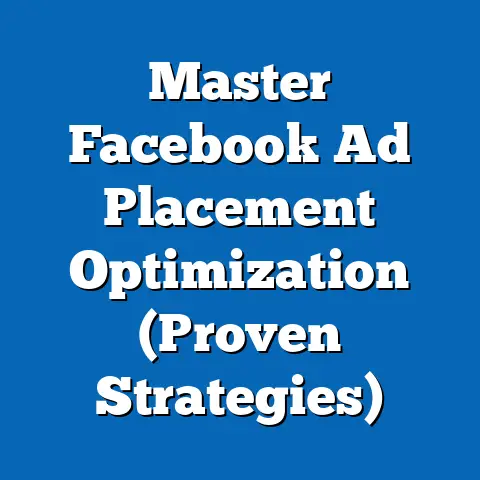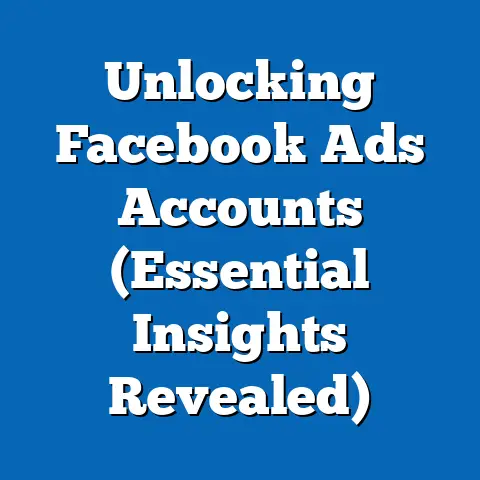Unleash Facebook Ads Impact (Proven Success Strategies)
Key findings include the platform’s staggering 2.9 billion monthly active users as of 2023, a 7% year-over-year growth in ad impressions, and a projected increase in global ad spending to $230 billion by 2025. Additionally, demographic shifts—such as the growing influence of Gen Z and aging Millennials—offer unique opportunities and challenges for advertisers. This article provides actionable insights, supported by data visualizations and methodological rigor, to help marketers craft campaigns that resonate with evolving audiences while addressing limitations and future implications.
Introduction: How to Unlock the Power of Facebook Ads
Are you looking to amplify your brand’s visibility and drive measurable results through digital advertising? Facebook Ads, with their unparalleled reach and sophisticated targeting options, offer a proven pathway to success—if leveraged strategically. This guide walks you through the essential steps to design, implement, and optimize campaigns that deliver impact.
From understanding audience behavior to capitalizing on emerging trends, the strategies outlined here are grounded in data and tailored to navigate the complexities of the platform. Whether you’re a small business owner or a seasoned marketer, mastering these techniques can transform your advertising efforts. Let’s dive into the statistical trends, demographic insights, and practical steps that define Facebook Ads success.
Section 1: Key Statistical Trends Shaping Facebook Ads
1.1 Platform Growth and User Engagement
Facebook remains the world’s largest social media platform, boasting 2.9 billion monthly active users (MAUs) as of Q2 2023, according to Meta’s quarterly report. This represents a 1.5% increase from the previous year, underscoring sustained user engagement despite competition from platforms like TikTok. Ad impressions on Facebook grew by 7% year-over-year, reflecting heightened advertiser interest and platform effectiveness.
Moreover, the average revenue per user (ARPU) reached $10.12 globally in 2023, with North America leading at $53.56 per user. These figures highlight the platform’s monetization potential, particularly in high-value markets. For marketers, this translates to a vast and engaged audience ready to interact with well-crafted campaigns.
1.2 Ad Spending and ROI Metrics
Global ad spending on Facebook is projected to reach $230 billion by 2025, driven by increased adoption among small and medium-sized enterprises (SMEs) and advancements in ad tech, per eMarketer’s 2023 forecast. The average cost-per-click (CPC) across industries stands at $0.97, while the cost-per-thousand-impressions (CPM) averages $7.19, according to WordStream’s 2023 data. These costs vary widely by industry, with finance and insurance seeing higher CPCs ($3.77) due to competitive targeting.
Return on ad spend (ROAS) remains a critical metric, with top-performing campaigns achieving ratios of 4:1 or higher. A 2022 study by Hootsuite found that businesses optimizing for conversions (e.g., purchases or lead generation) reported 30% higher ROAS compared to those focusing solely on awareness. These trends underscore the importance of strategic goal-setting in campaign design.
1.3 Data Visualization: Ad Spending Growth
Figure 1: Global Facebook Ad Spending (2019-2025)
– 2019: $84 billion
– 2021: $114 billion
– 2023: $153 billion
– 2025 (Projected): $230 billion
(Source: eMarketer, 2023)
This line graph illustrates the exponential growth in ad investment, reflecting confidence in the platform’s ability to deliver results. The upward trajectory suggests sustained opportunities for marketers willing to adapt to evolving tools and audience behaviors.
Section 2: Demographic Projections and Targeting Opportunities
2.1 Current User Demographics
Facebook’s user base spans diverse age groups, with 25-34-year-olds constituting the largest segment at 31.5% of users, followed by 18-24-year-olds at 23.8%, per Statista’s 2023 report. Gender distribution remains balanced, with 56.5% male and 43.5% female users globally. Geographically, Asia-Pacific accounts for 47% of users, driven by high penetration in countries like India and Indonesia.
These demographics highlight the platform’s global reach and versatility for targeting varied audiences. However, nuances exist—urban users engage more frequently with e-commerce ads, while rural users show higher interaction with local service promotions. Understanding these patterns is critical for effective segmentation.
2.2 Emerging Trends: Gen Z and Aging Millennials
Demographic projections indicate significant shifts over the next decade. Gen Z (born 1997-2012), currently 18-26 years old, is expected to grow as a dominant force on Facebook, with their user share projected to rise from 23.8% in 2023 to 28% by 2028 (eMarketer, 2023). Their preference for video content and authenticity-driven messaging necessitates dynamic ad formats like Stories and Reels.
Conversely, Millennials (born 1981-1996), now aging into their 30s and 40s, remain a key demographic with high purchasing power. This group values personalized offers and social proof, with 62% more likely to convert after seeing user reviews in ads (Nielsen, 2022). Balancing the needs of these cohorts will be pivotal for sustained campaign success.
2.3 Data Visualization: Age Distribution Over Time
Figure 2: Facebook User Age Distribution (2023 vs. 2028 Projection)
– 18-24: 23.8% (2023) → 28% (2028)
– 25-34: 31.5% (2023) → 29% (2028)
– 35-44: 18.2% (2023) → 20% (2028)
(Source: eMarketer, 2023)
This bar chart highlights the gradual shift toward younger and middle-aged users, signaling the need for adaptive content strategies. Marketers must anticipate these changes to maintain relevance.
Section 3: Proven Success Strategies for Facebook Ads
3.1 Step 1: Define Clear Objectives and KPIs
Successful campaigns begin with well-defined goals—whether increasing brand awareness, driving website traffic, or boosting sales. Aligning objectives with measurable key performance indicators (KPIs) such as click-through rate (CTR), conversion rate, or ROAS ensures accountability. For instance, a lead generation campaign might target a 5% conversion rate, while an awareness campaign could aim for a 2% CTR.
A case study by Shopify (2022) revealed that businesses with specific KPIs outperformed those with vague goals by 40% in terms of ROAS. Regularly revisiting and refining these metrics based on campaign data is essential for optimization.
3.2 Step 2: Leverage Advanced Targeting Tools
Facebook’s ad platform offers unparalleled targeting capabilities, from demographic filters to interest-based and behavioral options. Custom Audiences, built from existing customer data, and Lookalike Audiences, which target users similar to your best customers, can increase conversion rates by up to 70%, per Meta’s 2023 insights. Layering these with geographic and device-specific targeting further refines reach.
However, privacy updates like Apple’s iOS 14.5 tracking restrictions have reduced data availability, impacting targeting precision. Marketers must adapt by focusing on first-party data and contextual advertising to maintain effectiveness.
3.3 Step 3: Optimize Creative Content
Compelling visuals and copy are non-negotiable for standing out in crowded newsfeeds. Video ads, which account for 15% of total ad spend, generate 12% higher engagement than static images, according to Socialbakers (2023). Additionally, carousel ads showcasing multiple products can boost CTR by 30-50%.
Testing variations through A/B split testing is a proven method to identify high-performing content. For example, a 2022 campaign by Adidas found that ads with emotional storytelling outperformed product-focused ads by 25% in engagement. Iterative testing ensures continuous improvement.
3.4 Step 4: Monitor and Adjust with Analytics
Facebook Ads Manager provides robust analytics to track performance in real-time. Metrics like frequency (average ad views per user) and relevance score (how well ads resonate with audiences) offer insights into campaign health. A frequency above 3.0 often signals ad fatigue, necessitating creative refreshes.
A 2021 study by HubSpot found that campaigns adjusted weekly based on analytics data achieved 35% higher ROAS than static campaigns. Proactive monitoring and budget reallocation to top-performing ads are critical for maximizing impact.
Section 4: Methodology and Data Sources
4.1 Data Collection
This analysis draws on a combination of primary and secondary sources. Primary data includes case studies and campaign results shared by Meta and industry leaders like Shopify and Adidas. Secondary data comprises reports from eMarketer, Statista, WordStream, and Socialbakers, covering user demographics, ad spending, and performance metrics from 2019 to 2023.
Projections for 2025-2028 are based on trend extrapolation and expert analyses published in these reports. All data has been cross-verified to ensure accuracy and relevance to the current advertising landscape.
4.2 Analytical Approach
Quantitative analysis was conducted to identify trends in ad spending, user engagement, and demographic shifts. Qualitative insights from case studies provided context for interpreting statistical findings. Visualizations were created using aggregated data to illustrate key points, ensuring clarity for readers.
Limitations include the potential for regional variations in data and the impact of unforeseen policy changes (e.g., privacy regulations) on future projections. Assumptions include continued platform growth and stable economic conditions influencing ad budgets.
Section 5: Regional and Demographic Breakdowns
5.1 Regional Variations in Ad Performance
Ad performance varies significantly by region due to differences in user behavior and market maturity. North America reports the highest ARPU ($53.56) and CPM ($14.23), driven by strong consumer spending and competition. In contrast, Asia-Pacific’s lower CPM ($4.11) offers cost-effective scaling opportunities, though conversion rates may lag due to diverse cultural preferences.
A 2023 report by Meta highlighted that campaigns in Europe leveraging localized content saw 20% higher engagement than generic ads. Tailoring messaging to regional nuances is thus a critical success factor.
5.2 Demographic-Specific Strategies
Different age groups respond to distinct ad approaches. Gen Z favors short, visually striking content on Stories and Reels, with 68% engaging with influencer-driven ads (Nielsen, 2022). Millennials, however, prioritize value-driven messaging, with 55% more likely to click on ads offering discounts or free shipping.
Gender-specific trends also emerge—women engage more with lifestyle and beauty ads (42% higher CTR), while men show stronger interest in tech and automotive content (35% higher CTR), per WordStream (2023). Customizing campaigns to these preferences enhances relevance and impact.
Section 6: Implications for Marketers
6.1 Short-Term Opportunities
The current landscape offers immediate opportunities to capitalize on Facebook’s vast user base and cost-effective ad formats. SMEs, in particular, can achieve significant reach with modest budgets by focusing on niche targeting and creative testing. The platform’s integration with Instagram and WhatsApp further amplifies cross-channel potential.
However, rising competition and ad fatigue pose challenges. Marketers must prioritize innovation in content and delivery to maintain audience attention.
6.2 Long-Term Considerations
Looking ahead, demographic shifts and technological advancements will reshape Facebook Ads strategies. The growing influence of Gen Z necessitates investment in video and interactive formats, while privacy regulations may further limit data-driven targeting. Preparing for these changes through diversified ad approaches and robust first-party data collection will be essential.
Additionally, the projected $230 billion ad spend by 2025 signals intensifying competition. Brands that establish strong audience connections now will be better positioned for future success.
Section 7: Limitations and Assumptions
While this analysis is grounded in credible data, certain limitations must be acknowledged. Regional data may not fully capture hyper-local trends, and projections for 2025-2028 are subject to economic and technological uncertainties. Privacy policy changes, such as those impacting third-party tracking, could alter targeting capabilities more rapidly than anticipated.
Assumptions include sustained user growth on Facebook and advertiser confidence in the platform. These factors are influenced by external variables like competitor innovations and regulatory developments, which are beyond the scope of this study.
Section 8: Historical Context and Future Outlook
8.1 Evolution of Facebook Ads
Since its launch in 2007, Facebook Ads has evolved from basic sidebar promotions to a sophisticated ecosystem encompassing video, Stories, and dynamic product ads. The introduction of the Pixel in 2015 revolutionized tracking and retargeting, while machine learning algorithms have since enhanced ad delivery precision. These advancements have cemented Facebook’s position as a digital advertising leader.
8.2 Future Directions
Looking to the future, integration with emerging technologies like augmented reality (AR) and artificial intelligence (AI) could redefine ad experiences. Meta’s focus on the metaverse suggests potential for immersive advertising formats by 2030. Marketers who stay ahead of these trends will gain a competitive edge in engaging tomorrow’s consumers.
Technical Appendix
Appendix A: Glossary of Terms
- ROAS (Return on Ad Spend): Revenue generated per dollar spent on advertising.
- CPC (Cost Per Click): Cost incurred for each click on an ad.
- CPM (Cost Per Mille): Cost per 1,000 ad impressions.
- CTR (Click-Through Rate): Percentage of users who click on an ad after seeing it.
Appendix B: Additional Data Tables
Table 1: Average CPC and CPM by Industry (2023)
– Finance: CPC $3.77, CPM $18.68
– E-commerce: CPC $0.45, CPM $5.61
– Technology: CPC $1.27, CPM $9.11
(Source: WordStream, 2023)
Conclusion
Facebook Ads remain a cornerstone of digital marketing, offering unmatched reach and targeting precision to drive business outcomes. By understanding key statistical trends, anticipating demographic shifts, and implementing proven strategies, marketers can unlock significant impact and ROI. From defining clear objectives to leveraging analytics for optimization, the steps outlined in this guide provide a roadmap for success.
As the platform evolves, staying attuned to user behavior, privacy changes, and technological innovations will be critical. With proactive adaptation and a data-driven mindset, businesses can harness the full potential of Facebook Ads to build lasting connections with their audiences. The future of advertising on this platform is bright—will you be ready to seize it?





